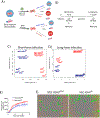Unveiling the role of KSHV-infected human mesenchymal stem cells in Kaposi's sarcoma initiation
- PMID: 38773828
- PMCID: PMC12068558
- DOI: 10.1002/jmv.29684
Unveiling the role of KSHV-infected human mesenchymal stem cells in Kaposi's sarcoma initiation
Abstract
Kaposi's sarcoma (KS) may derive from Kaposi's sarcoma herpesvirus (KSHV)-infected human mesenchymal stem cells (hMSCs) that migrate to sites characterized by inflammation and angiogenesis, promoting the initiation of KS. By analyzing the RNA sequences of KSHV-infected primary hMSCs, we have identified specific cell subpopulations, mechanisms, and conditions involved in the initial stages of KSHV-induced transformation and reprogramming of hMSCs into KS progenitor cells. Under proangiogenic environmental conditions, KSHV can reprogram hMSCs to exhibit gene expression profiles more similar to KS tumors, activating cell cycle progression, cytokine signaling pathways, endothelial differentiation, and upregulating KSHV oncogenes indicating the involvement of KSHV infection in inducing the mesenchymal-to-endothelial (MEndT) transition of hMSCs. This finding underscores the significance of this condition in facilitating KSHV-induced proliferation and reprogramming of hMSCs towards MEndT and closer to KS gene expression profiles, providing further evidence of these cell subpopulations as precursors of KS cells that thrive in a proangiogenic environment.
Keywords: KSHV; Kaposi's sarcoma; mesenchymal‐to‐endothelial transition.
© 2024 The Author(s). Journal of Medical Virology published by Wiley Periodicals LLC.
Conflict of interest statement
CONFLICT OF INTEREST STATEMENT
The authors declare no conflict of interest.
Figures







References
-
- Chang Y, Cesarman E, Pessin MS, et al. Identification of herpesvirus-like DNA sequences in AIDS-associated Kaposi’s sarcoma. Science. 1994;266:1865–1869. - PubMed
-
- Ensoli B Kaposi’s sarcoma: a result of the interplay among inflammatory cytokines, angiogenic factors and viral agents. Cytokine Growth Factor Rev. 1998;9:63–83. - PubMed
-
- Stürzl M, Brandstetter H, Zietz C, et al. Identification of interleukin-1 and platelet-derived growth factor-B as major mitogens for the spindle cells of Kaposi’s sarcoma: a combined in vitro and in vivo analysis. Oncogene. 1995;10:2007–2016. - PubMed
Publication types
MeSH terms
Grants and funding
LinkOut - more resources
Full Text Sources
Medical
Molecular Biology Databases

